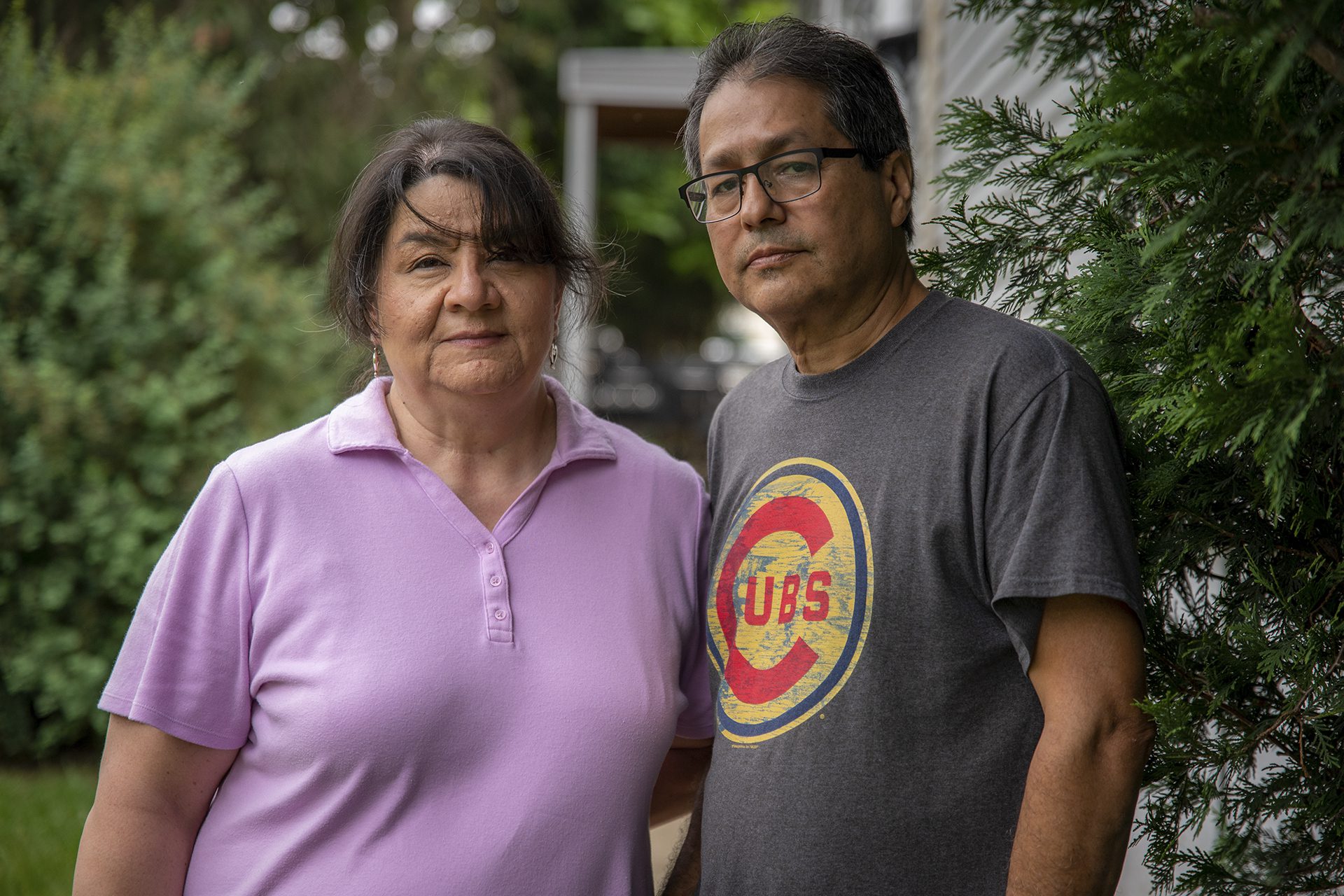 Jonathan Aguilar/Revista sin fronteras
Jonathan Aguilar/Revista sin fronterasUna fábrica local fue en su día el mayor productor de torio del mundo. Este otoño, la "capital radiactiva del Medio Oeste" realiza una última limpieza.
Sandra Arzola estaba descansando en su casa del oeste de Chicago un fin de semana de 1995, cuando oyó que llamaban a la puerta. Recién casada, compartía el dúplex gris con su marido, su madre y su hermana, y los miembros de la familia entraban y salían constantemente. Pero cuando Sandra abrió la puerta aquel día, lo que descubrió cambiaría para siempre su forma de ver su casa y su comunidad suburbana.
En la puerta había una mujer que representaba a Envirocon, una empresa de limpieza medioambiental. La mujer dijo que había torio en la propiedad de la familia y que, si les parecía bien, vendrían trabajadores a retirarlo. Era la primera vez que Sandra oía hablar del torio.
Noticias que ponen el poder en el punto de mira y a las comunidades en el centro.
Suscríbase a nuestro boletín gratuito y reciba actualizaciones dos veces por semana.
"Me pilló por sorpresa", dijo. "Pero [el representante] me hizo creer que todo iba a ir bien".
Sin saberlo, los Arzola habían comprado su entrada en lo que el Chicago Tribune: en 1979 llamada "la capital radiactiva del Medio Oeste". Poco después de comprar la propiedad, la Agencia de Protección del Medio Ambiente de EE.UU. la designó zona Superfund por los residuos peligrosos que había en su patio.
La fuente del peligro era la antigua fábrica situada a una manzana al sur de la casa de los Arzola, por la que Jesse Arzola pasaba con frecuencia mientras paseaba a sus perros. De 1932 a 1973, la fábrica fue el mayor productor de tierras raras y compuestos radiactivos de torio del mundo. Empezó produciendo lámparas y más tarde suministró torio para el desarrollo de la bomba atómica del gobierno federal. Pero quizá el legado más duradero de la fábrica, al menos en el oeste de Chicago, sean los nocivos residuos radiactivos que se vertían en estanques, se apilaban en la fábrica y se enterraban alrededor de casas y aceras por toda la ciudad.
Ya en la década de 1940, los residentes expresaron su preocupación por el material tóxico, pero la fábrica, propiedad de Kerr-McGee Chemical Corporation, lo desestimó con frecuencia. Hasta principios de la década de 1970 no se establecieron normas exhaustivas de protección del medio ambiente, por lo que la fábrica pudo deshacerse de sus residuos nucleares durante décadas.
La empresa y el gobierno han tardado otro tanto en limpiar los residuos radiactivos. En 2015, los terrenos radiactivos bajo jurisdicción federal cercanos a la fábrica se han limpiado conforme a las normas de la EPA. No quedan riesgos para la salud derivados del terreno, según funcionarios del gobierno.
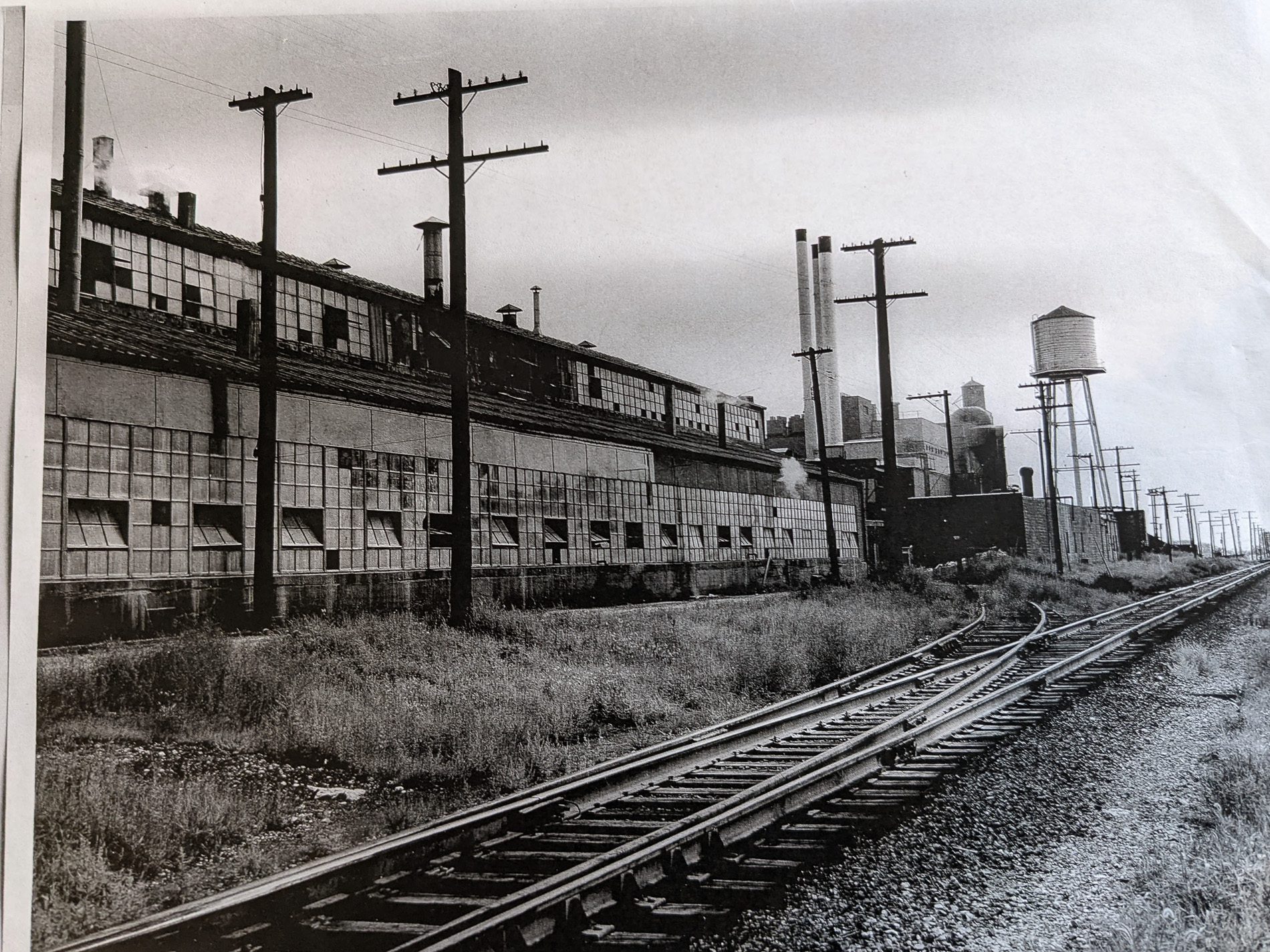
Pero por debajo de la fábrica, las aguas subterráneas siguen contaminadas con una serie de toxinas -sobre todo uranio- que superan las normas de protección. La Agencia de Gestión de Emergencias de Illinois, que tiene jurisdicción sobre el lugar, espera que las obras de rehabilitación empiecen este otoño. Aunque los habitantes de la zona no utilizan las aguas subterráneas contaminadas, el Estado afirma que se trata del último problema de contaminación conocido, y se espera que la eliminación de la mayor parte de ellas elimine cualquier preocupación persistente para los residentes.
Mientras las autoridades municipales y algunos residentes están ansiosos por borrar el estigma de la contaminación nuclear de la imagen de la ciudad, muchos de los nuevos residentes, entre los que me incluyo, acaban de conocer la larga historia del torio de su barrio.
"La gente no quiere hablar de ello", dice Jesse Arzola, "porque tiene miedo a lo desconocido".
Los Arzola formaron parte de una oleada de nuevos residentes que se trasladaron a este suburbio a 50 km al oeste de Chicago a partir de la década de 1980. De 1980 a 2007, los residentes blancos en la zona de la fábrica se redujeron en dos tercios y los hispanos casi se duplicaron, según un análisis del Daily Herald. Muchos de los nuevos residentes de West Chicago, especialmente los que no hablaban inglés, no sabían del peligro de radiación cuando se mudaron.
La exposición prolongada o a niveles elevados de radiación puede dañar el material genético de las células y provocar cáncer y otras enfermedades más adelante, especialmente en el caso de niños, que son más sensibles a la radiación. En el oeste de Chicago sólo se han realizado dos estudios de salud pública, publicados a principios de la década de 1990. Ambos detectaron tasas elevadas de cáncer en el código postal 60185, que incluye el barrio que rodea la fábrica.
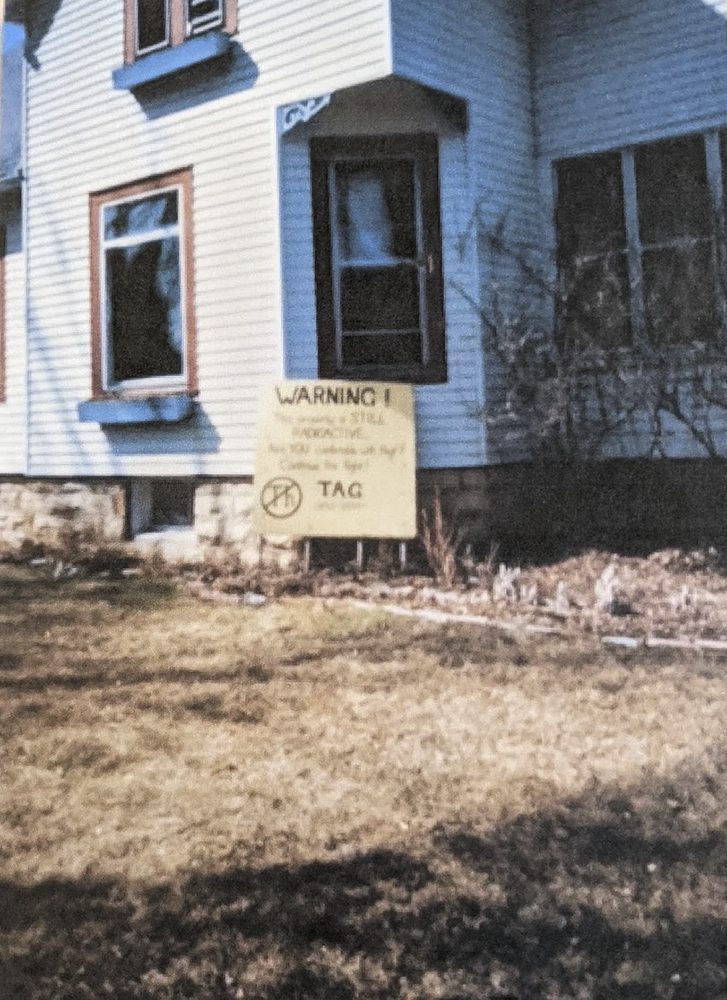
En la actualidad, muchos residentes siguen sospechando que sus cánceres y otras enfermedades debilitantes están relacionados con la contaminación de las fábricas. Las barreras lingüísticas y la discriminación se suman a la desconfianza de muchos residentes latinos.
Y décadas de secretismo en torno a la fábrica han dejado un legado de preocupaciones.
Cuando Sandra Arzola visitó su casa por primera vez en 1990 con su madre y su hermana, vio carteles en las ventanas de las casas vecinas con una gran "Th" rodeada y tachada.
"¿A qué viene todo eso?", preguntó.
"Oh, no lo sé", respondió el agente inmobiliario.
Sandra Arzola desearía que le hubieran dicho la verdad cuando buscaba casa. Décadas después, ella y su marido viven en otra casa del mismo barrio. Sigue sin fiarse de las declaraciones oficiales de que su propiedad y el agua potable de la ciudad son seguras. Debido a su preocupación, utilizan agua embotellada en lugar de agua del grifo para cocinar y beber.
"Si la agente inmobiliaria hubiera sido más franca al principio, entonces podría decirle: 'No importa' o 'Enséñame otra cosa'", dijo Sandra Arzola. "Pero no fue sincera".
Décadas de vertidos no regulados
Los retos a los que se enfrentan hoy los residentes de West Chicago empezaron hace 90 años, cuando Charles R. Lindsay trasladó su fábrica de lámparas desde Chicago a lo que entonces era un pueblecito sin desarrollar con múltiples conexiones ferroviarias. La fábrica, ahora conocida oficialmente como Instalación de Tierras Raras, tomaba mineral de monacita y utilizaba potentes ácidos para extraer minerales con los que fabricar linternas de gas, que quemaban nitrato de torio para emitir un resplandor incandescente. Durante la Segunda Guerra Mundial, también suministró torio al gobierno federal para desarrollar las bombas atómicas que posteriormente se lanzaron sobre Nagasaki e Hiroshima (Japón).
Durante sus cuatro décadas de funcionamiento, la Fábrica de Tierras Raras procesó hasta 141.000 toneladas de monacita. Los residuos líquidos del proceso de extracción se vertían en estanques sin revestimiento alrededor de la fábrica, filtrándose a la capa freática circundante. Los residuos sólidos, un material negro parecido a la arena conocido como estériles de torio, se amontonaban en el emplazamiento. Los veteranos cuentan historias de cómo se colaban en el recinto de la fábrica y jugaban en el "Monte Torio". Cuando la pila crecía demasiado, los residuos se transportaban por carretera hasta una nueva pila en el parque Reed Keppler.
Ante las crecientes pilas de residuos tóxicos, Lindsay ideó otra solución: ofrecer los residuos a los residentes para ajardinar. Desde la década de 1930 hasta la de 1950, los residuos radiactivos de torio se distribuyeron por toda la ciudad, mezclados con hormigón para construir cimientos, con tierra vegetal para jardines y a lo largo de las carreteras. La empresa siguió haciéndolo cuando los riesgos de la exposición a la radiación se hicieron ampliamente conocidos a partir de finales de los años 40 por sus efectos en Supervivientes japoneses de la bomba atómica.
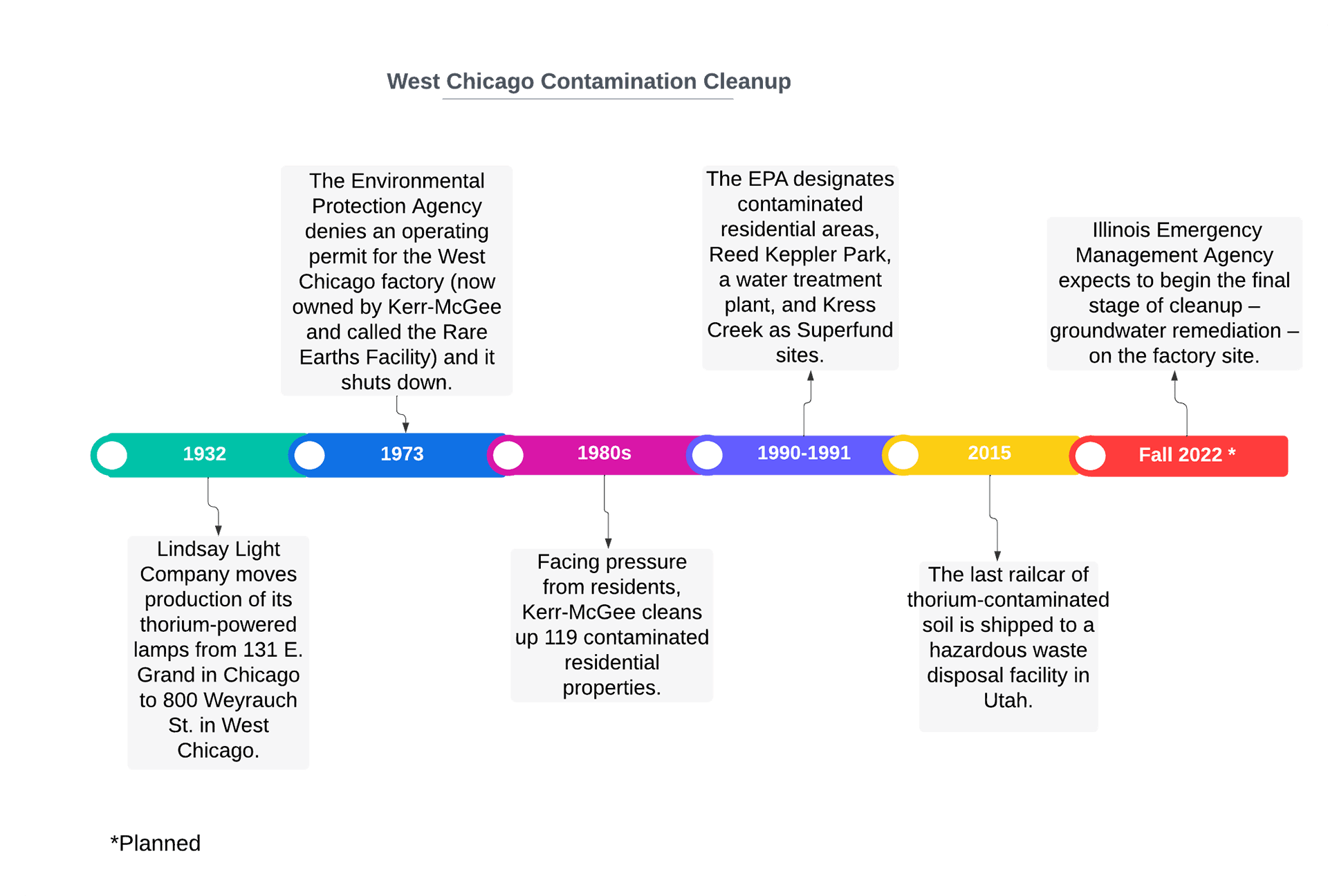
Poco después de que la fábrica se trasladara a West Chicago, la gente empezó a quejarse. En 1941, los vecinos demandaron a Lindsay Light por liberar ácido fluorhídrico en el aire, que mató árboles y arbustos cercanos.
El gobierno federal no comenzó regulación de los materiales nucleares hasta 1954. A partir de 1957, la empresa recibió repetidas citaciones por infracciones de seguridad, entre ellas no vallar las zonas de almacenamiento radiactivo, exponer a los trabajadores a niveles de radiación superiores a las normas y eliminar los residuos de forma inadecuada.
A medida que el movimiento ecologista ganaba fuerza en la década de 1960, la creciente presión pública empujó al Congreso a crear la Agencia de Protección del Medio Ambiente y aprobar la Ley de Aire Limpio de 1970 y la Ley de Agua Limpia de 1972. El resultado fueron nuevas normas de gran alcance -y obligaciones para con el público estadounidense- para empresas como Kerr-McGee, que se habían acostumbrado a operar con una supervisión limitada.
Las notas internas de la época muestran a los ejecutivos de la empresa luchando por responder.
"Esta visita es la precursora de muchas visitas futuras y de una vigilancia más estrecha, y debemos aprender a ir un paso por delante", escribió O.L. Daigle, director de la planta de tierras raras, en un memorándum de 1972 sobre una próxima visita de la EPA.
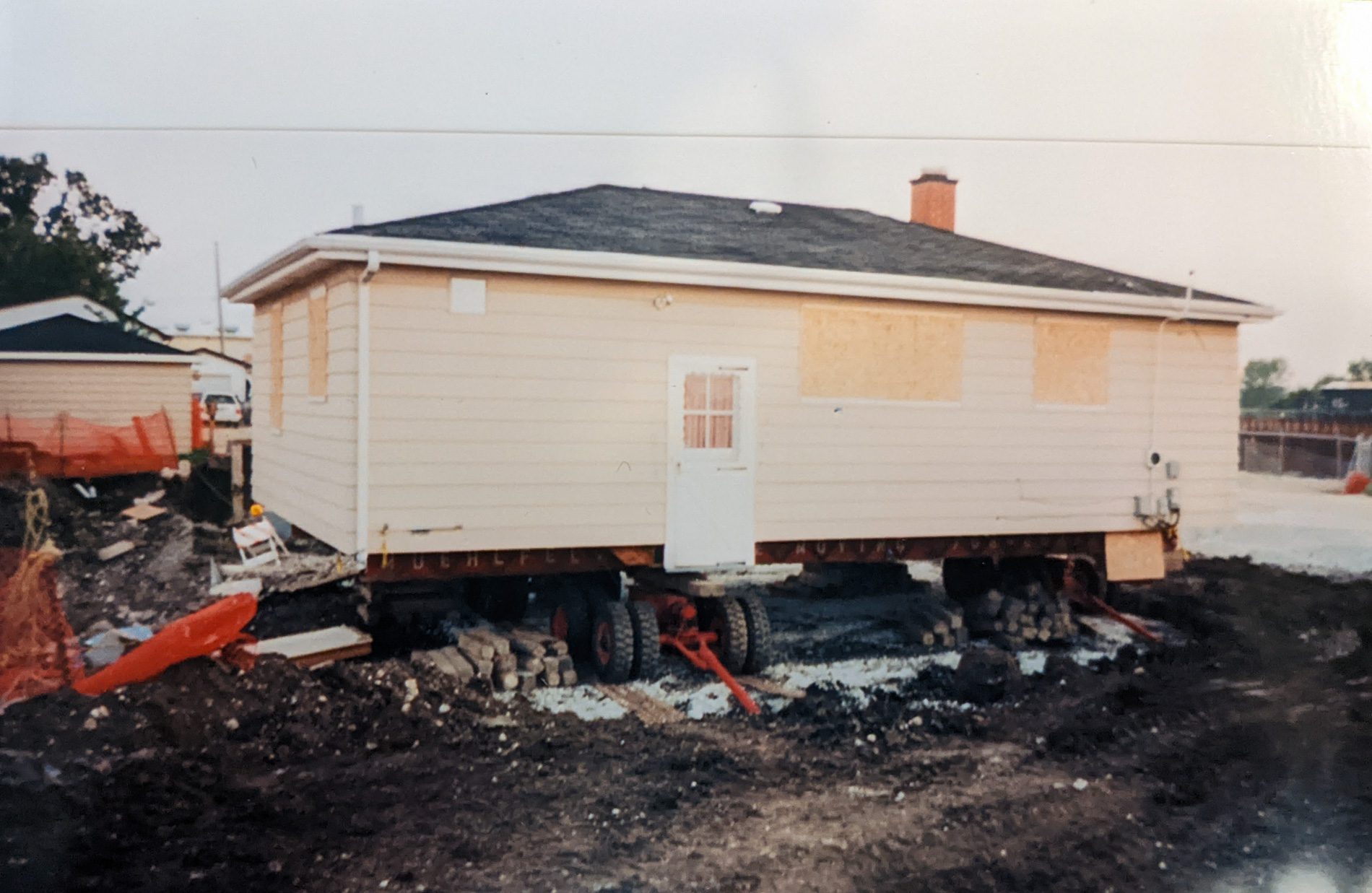
Al año siguiente, Kerr-McGee no había cumplido una amplia serie de nuevas normas de seguridad medioambiental. La EPA denegó la solicitud de permiso de explotación de la empresa y la fábrica cerró en 1973. Era más barato cesar las operaciones que cumplir las nuevas normas.
En 1980, Kerr-McGee había iniciado el proceso de cierre definitivo de las instalaciones de West Chicago. La presión de los residentes y de la ciudad empujó a la empresa a iniciar la limpieza de 119 propiedades residenciales contaminadas.
Sin embargo, Kerr-McGee tenía otro plan que preocupaba a los residentes: almacenar permanentemente 13 millones de pies cúbicos de residuos radiactivos en el emplazamiento de la fábrica, en una celda de cuatro pisos y 27 acres cubierta de arcilla. Los residentes, preocupados, crearon una organización, el Thorium Action Group, para luchar contra la propuesta de la empresa. Esto dio lugar a más de una década de batallas legales entre los residentes, la ciudad de West Chicago y el estado de Illinois -que querían el torio fuera de la ciudad- y la empresa y la Comisión Federal de Regulación Nuclear, que insistían en que los residuos podían almacenarse de forma segura en este barrio densamente poblado de West Chicago.
Después de que el estado de Illinois asumiera la supervisión de los residuos de la fábrica, la disputa pareció finalmente cerca de resolverse. En 1991, los legisladores del estado aprobaron un proyecto de ley que cobraría a la empresa $130 millones cada año por almacenar los residuos in situ. En lugar de pagar la factura, Kerr-McGee decidió enviar los materiales contaminados a un vertedero de residuos peligrosos de Utah.
Muchos nuevos residentes estaban a oscuras
Trasladar los residuos de torio fuera de la ciudad llevaría más de dos décadas. Mientras tanto, seguía existiendo el problema de los residuos radiactivos esparcidos por el barrio.
La EPA realizó una serie de exploraciones aéreas, estudios calle por calle y otras pruebas para evaluar los daños. En 1991, las propiedades residenciales contaminadas -el recuento final fue de 676 de las 2.174 inspeccionadas-, así como el parque Reed Keppler, una planta de tratamiento de aguas residuales y el arroyo Kress, al sur de la fábrica, se incluyeron en la Lista Nacional de Prioridades de la EPA como lugares del Superfondo. Según la EPA, la contaminación de la planta de tratamiento de aguas residuales se produjo al recibir residuos de torio como relleno durante la construcción, y no por aguas residuales contaminadas.
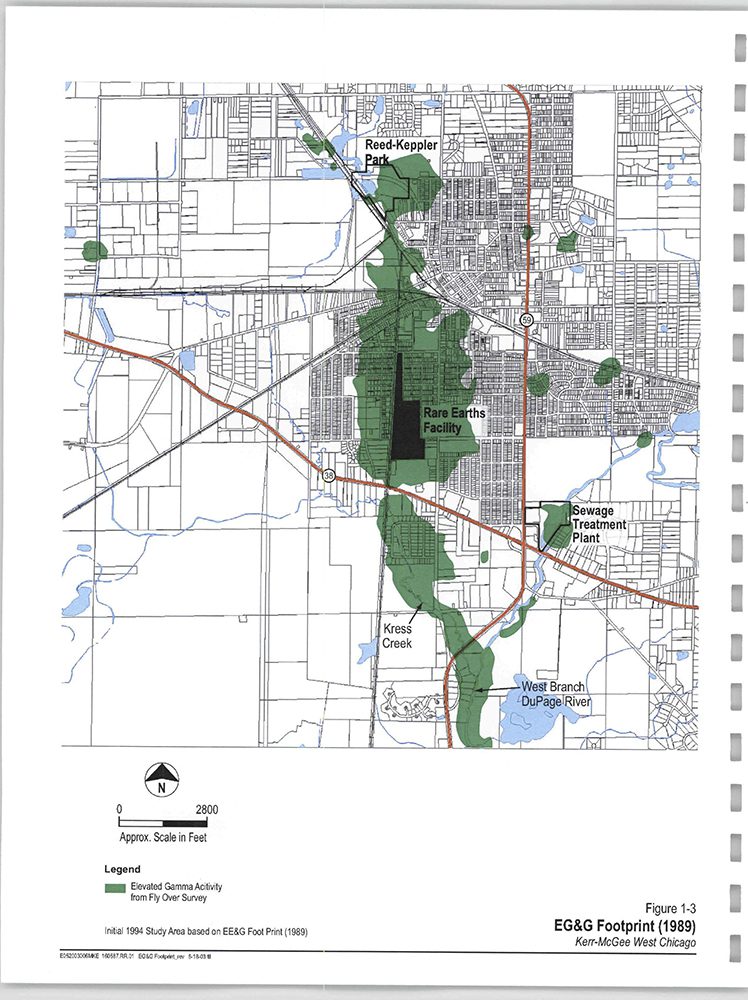
La casa de la familia Arzola estaba entre esos lugares. Tras la visita de Envirocon, comenzó la limpieza. Trabajadores con trajes blancos para materiales peligrosos excavaron hasta dos metros de profundidad alrededor de la propiedad. "Lo único que quedó intacto fue la casa", dice Jesse Arzola. "Excavaron hasta los cimientos".
El equipo de limpieza también destrozó la acera. Para llegar a la puerta de su casa, la familia, incluida la hija de dos años de la pareja, cruzó tablones de madera de metro y medio de ancho sobre el enorme agujero en el suelo. No se fiaban de la robustez de las barandillas, y en su lugar caminaban con cuidado por el centro. Tras la excavación, rellenaron la zona con tierra limpia. Todo el proceso duró más de seis meses.
La experiencia de los Arzola no es rara. Los agentes inmobiliarios de West Chicago han operado con una política de "no preguntar, no decir", dijo Dan Czuba, agente inmobiliario y antiguo residente de West Chicago. A diferencia de lo que ocurre con el radón o el plomo, los agentes inmobiliarios nunca han recibido directrices del estado ni de ninguna junta de licencias para revelar otros subproductos nocivos del torio.
La gente ha tenido que hacer sus propios deberes y decidir si una casa suponía un riesgo o no. "A día de hoy", dijo Czuba, "todavía no sé si hubo una declaración oficial de: 'El torio le hará daño'".
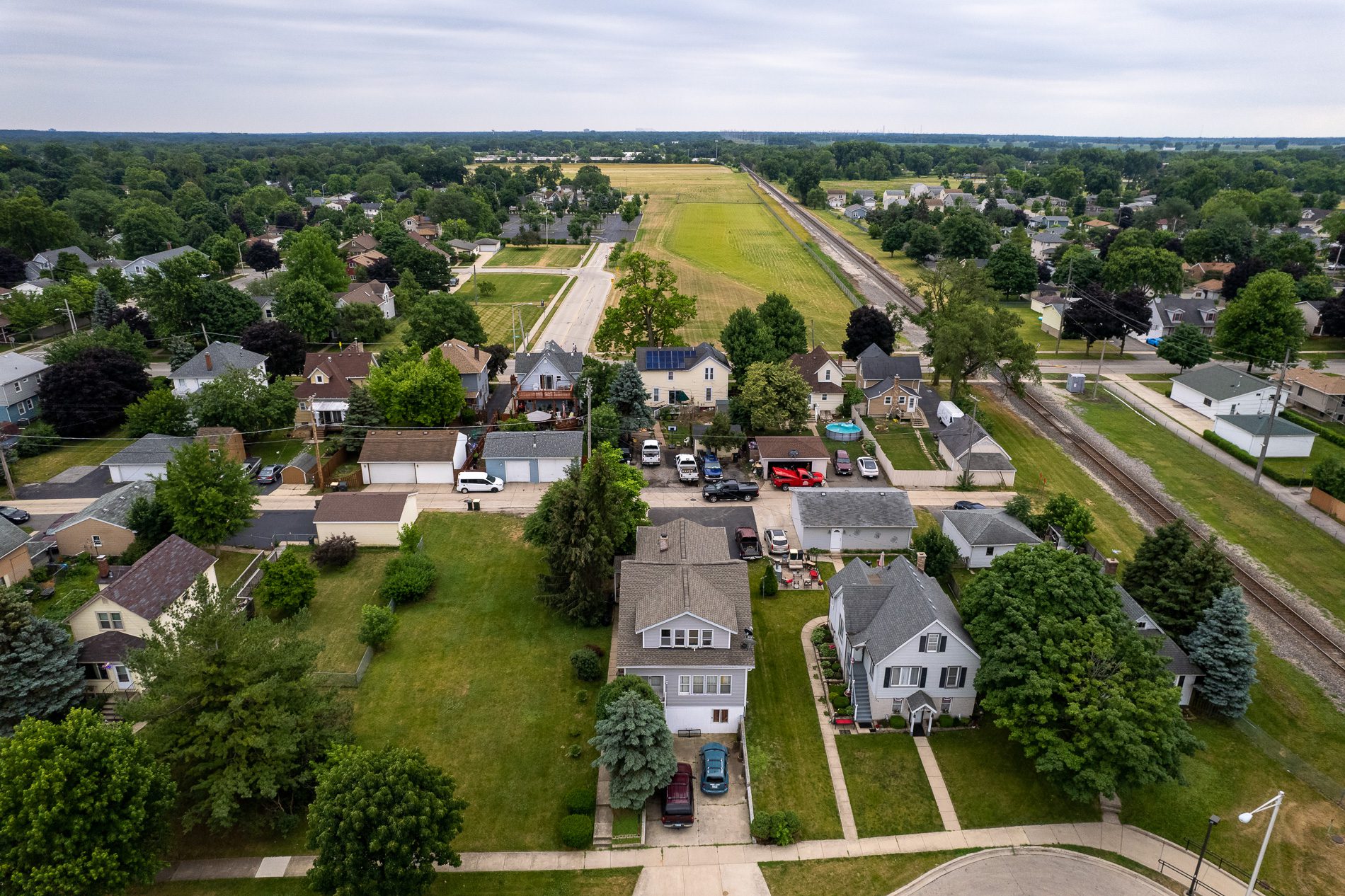
Los residentes latinos también siguieron mudándose durante las décadas posteriores al cierre de la fábrica. "La comunidad mexicana quería una vivienda en propiedad", explica Czuba. "Cogieron la bazofia y la chatarra de los no hispanos. No discutían ni se quejaban, los arreglaban".
En 2010, West Chicago se convirtió en la única ciudad del condado de DuPage con población mayoritariamente latina. En la actualidad, 55% de sus más de 25.000 residentes hablan un idioma distinto del inglés en casa, y 32% han nacido en el extranjero. Los activistas creen que muchos de los nuevos residentes no estaban del todo informados, o no lo estaban en absoluto, sobre los riesgos de vivir cerca de la antigua fábrica.
"Hubo mucha huida de los blancos, lo que trajo a familias mexicanas que no conocían [la historia], y en muchos casos ni siquiera hablaban el idioma para saberlo", dijo Cristóbal Cavazos, activista local por los derechos de los inmigrantes de Immigrant Solidarity DuPage.
A lo largo de las décadas, varios grupos han intentado dar a conocer el torio. El Thorium Action Group estuvo activo hasta principios de la década de 2000. Una vez que la EPA intervino y Kerr-McGee accedió a trasladar los residuos, el grupo se disipó. "En general, todos pensamos que el mensaje se había escuchado y que se estaba haciendo algo", dijo Czuba, el único agente inmobiliario del grupo.
”"A día de hoy", dijo Czuba, "todavía no sé si hubo una declaración oficial de: 'El torio te hará daño'".
Czuba señala que ningún residente latino participaba en el grupo, aunque la población de West Chicago ya era hispana en un 17% en 1980.
Anna Maria Escamilla Jacobo es una antigua residente de West Chicago cuyo abuelo, Viviano Escamilla, trabajó en la fábrica desde la década de 1950. Jacobo afirma que residentes como su abuelo conocían los riesgos, pero no se atrevían a denunciarlos por miedo a la discriminación.
"La mentalidad era: 'nadie nos va a escuchar porque somos mexicanos. Podemos intentarlo, pero no nos va a servir de nada'", dice Jacobo. "Mi abuelo temía que si decía algo, habría repercusiones para él, la familia y la comunidad hispana. Decía: 'No puedes hacer nada, no puedes hacer nada', lo cual era muy triste".
En 2007, Kathy Reinke-Bentham puso en marcha otro grupo comunitario porque ninguno de sus vecinos conocía el asunto. Había visto cómo se excavaba la propiedad de al lado para extraer torio y luego cambiaba de dueño. La siguiente propietaria, María Salazar, no tenía ni idea. Reinke-Bentham consiguió la ayuda de Salazar para traducir la información al español y recorrió el barrio repartiendo folletos e invitando a la gente a reuniones.
Hoy en día, los residentes siguen difundiendo el legado de torio de la ciudad y los nuevos problemas medioambientales. Cavazos grupoSolidaridad con los Inmigrantes de DuPage, que comenzó en 2007, es una de las organizaciones que movilizan a los residentes contra la propuesta de construir una estación de transferencia de residuos en el oeste de Chicago. Los miembros de Solidaridad con los Inmigrantes de DuPage consideran que la estación, que sería la segunda de la ciudad, es un ejemplo más de los peligros para la salud medioambiental que afectan injustamente a esta comunidad minoritaria.
Más información
El legado tóxico de la fábrica en el oeste de Chicago también sigue afectando a los residentes. Aunque la EPA anunció que la limpieza de las propiedades residenciales había terminado en 2003, la agencia descubrió posteriormente 13 propiedades que no se habían limpiado conforme a sus normas y necesitaban más limpieza.
La agencia también dijo que se enviaron cartas a los propietarios una vez que sus propiedades fueron remediadas. Los Arzola no recuerdan haber recibido ninguna. Funcionarios municipales, estatales y federales también decidieron no instituir notificaciones de escrituras o restricciones que revelaran la contaminación, para garantizar que las propiedades no vieran su reputación injustamente manchada, según el Daily Herald. Cualquier información que los compradores puedan recibir sobre anteriores exploraciones radiológicas o medidas correctoras depende ahora de la voluntad de los vendedores de transmitirla.
La falta de información fácilmente accesible en torno a la contaminación y la limpieza ha dejado a algunos residentes con la persistente preocupación de que pueda haber otros focos ocultos de radiación por la ciudad. Algunos temen plantar huertos comestibles. Los Arzola quieren un escáner actualizado de la zona. Muchos han oído hablar del torio lo suficiente como para preocuparse, pero no han oído suficientes detalles como para confiar en la seguridad de su entorno.
"¿Es por el torio?"
Erika Bartlett creció jugando junto a las vías del tren y bajo los viejos robles de su jardín, una casa más al oeste y al otro lado de la vía férrea que la de los Arzola. Cuando le diagnosticaron leucemia en 2012, a los 34 años, un amigo le preguntó si había algo a lo que pudiera haber estado expuesta.
"Espera un momento, en realidad lo estaba", le dijo Bartlett a su amiga. Pensó en sus años de instituto, cuando los robles, los columpios y la piscina de su casa fueron retirados durante la rehabilitación radiológica. Bartlett se dio cuenta de que había pasado su infancia, desde los cuatro años, en un barrio lleno de residuos nucleares.
Se preguntó cuántas personas que vivían cerca de la fábrica tenían problemas de salud similares. Esto la llevó a emprender una investigación personal de un año sobre el legado de torio de la ciudad.
Entre 2012 y 2016, mientras Bartlett se sometía a un tratamiento contra el cáncer, llamó a las puertas de los barrios de los alrededores de la fábrica, un área que abarca aproximadamente una milla cuadrada. Encontró más de 200 casos de cáncer y otras enfermedades que podrían derivarse de la exposición a la radiación, incluidos defectos de nacimiento, Hashimoto y anemia aplásica, la enfermedad que mató a la pionera investigadora de la radiactividad Marie Curie en 1934.
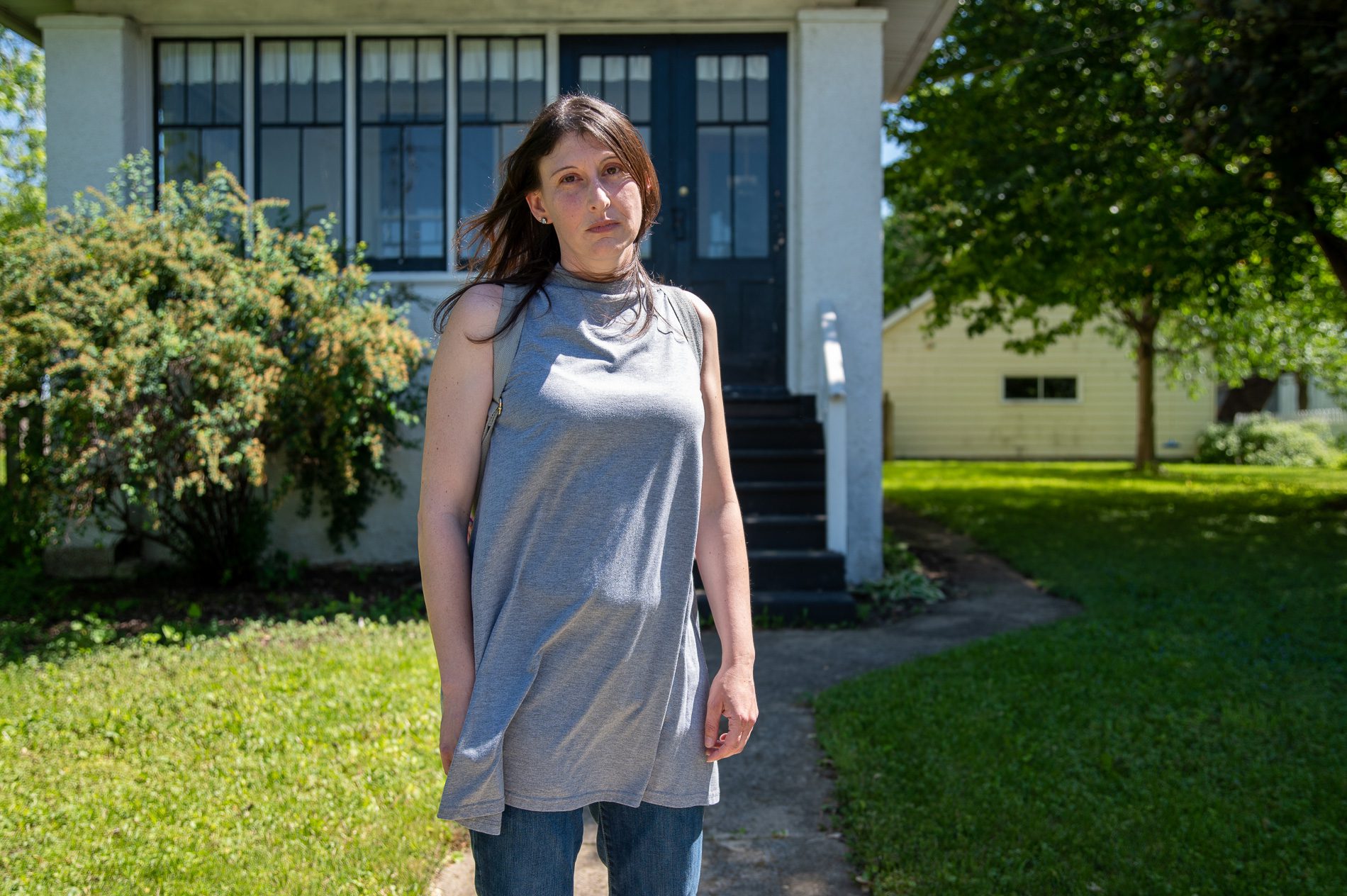
"Cuando empecé, pensé que no encontraría nada", dijo Bartlett. "Pero bloque tras bloque, me pareció más grande de lo que pensaba".
La EPA estimó queantes de que se retiraran los residuos, los niveles de radiación en algunos barrios residenciales del oeste de Chicago aumentaban el riesgo de cáncer a lo largo de la vida hasta 70 veces más de lo aceptable. Esto significa que si 10.000 personas vivieran en esas zonas de exposición máxima, 70 de ellas desarrollarían cáncer, además del riesgo de que 1 de cada 3 estadounidenses desarrolle cáncer a lo largo de su vida. Esto no tiene en cuenta otros posibles efectos sobre la salud como las enfermedades tiroideas y autoinmunes.
La sólo estudios sanitarios oficiales El Departamento de Salud Pública de Illinois llevó a cabo hace más de tres décadas un estudio sobre el impacto en las personas que vivían cerca de la fábrica. Entre los residentes del código postal 60185, los estudios de 1990 y 1991 detectaron tasas elevadas de cáncer, incluidos melanomas y cánceres de pulmón, colorrectal y de mama. Sin embargo, al agrupar a las personas expuestas y no expuestas, los investigadores señalaron que podrían haberse enmascarado más diferencias.
En 2006, las evaluaciones de seguimiento del IDPH concluyeron que los cuatro emplazamientos del Superfondo no suponían "ningún peligro aparente para la salud pública". Eso no significa que los residentes no estén viviendo con impactos continuos sobre la salud. Un informe de 1994 señala que "debido al largo periodo de latencia de la mayoría de los cánceres, los casos actuales no reflejan una exposición reciente". Hoy en día, la gente puede seguir experimentando problemas de salud derivados de la exposición décadas antes.
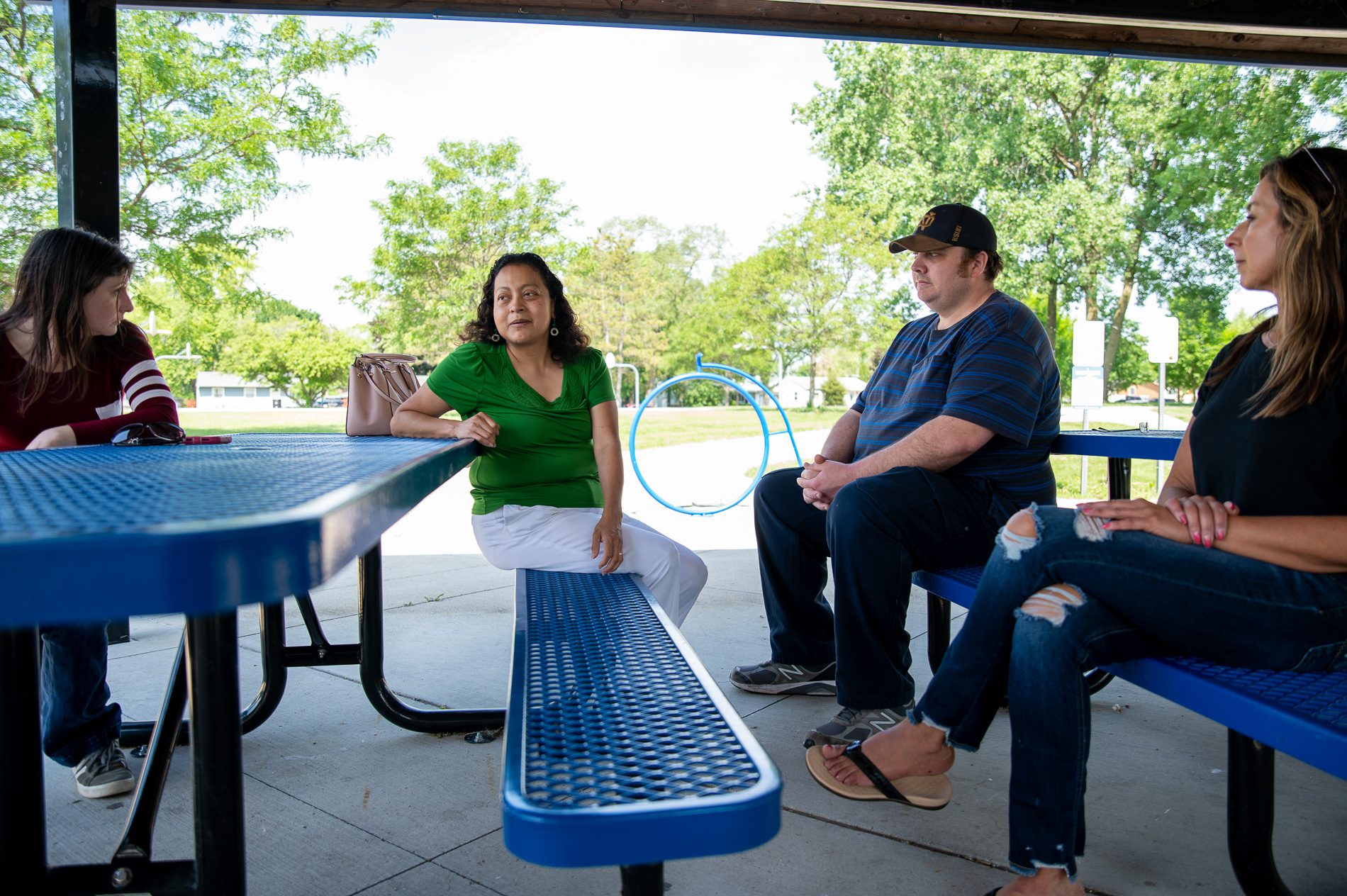
En los grupos de Facebook, los residentes de West Chicago a veces comparan notas sobre sus problemas de salud. Anna Maria Escamilla Jacobo vio uno de estos hilos en 2014. Comentario tras comentario, leyó sobre vecinos con enfermedades pulmonares, cáncer de aparición temprana y trastornos autoinmunes.
"Joder, sí", pensó, "este soy yo por todas partes". Fue la primera vez que se dio cuenta de que sus propias enfermedades podían deberse a vivir cerca de la fábrica de Kerr-McGee.
Jacobo y su hermana, Ester Escamilla Hughes, crecieron en una pequeña casa inicial al oeste de la fábrica, frente al parque Pioneer.
En 1989, justo cuando Ester se graduó en el instituto, una inspección aérea de la EPA descubrió que la zona que rodeaba la fábrica, incluido el parque y el camino diario de las hermanas al colegio, emitía niveles elevados de radiación gamma. En algunas zonas, la radiación era hasta 40 veces superior a la media de lo que una persona podría encontrar normalmente.
Las hermanas Escamilla han tardado años en desentrañar el impacto potencial de vivir junto a la fábrica.
Ambos se mudaron de la casa de su infancia en 1995. Al año siguiente, a los 27 años, Jacobo fue diagnosticado de Hashimoto, una enfermedad autoinmune que afecta a las glándulas tiroides. El tiroides es uno de los órganos con mayor riesgo de sufrir daños tras la exposición a la radiación, especialmente en niños. Jacobo también desarrolló artritis reumatoide a los 44 años.
"El reumatólogo me dijo que mis resultados de laboratorio y radiografías eran los de una persona de 80 años con artritis reumatoide", dijo Jacobo.

A su hermana le diagnosticaron una serie de enfermedades poco después de cumplir los 40, entre ellas Hashimoto, artritis reumatoide y otras dolencias que afectaban a sus pulmones y su sistema inmunitario.
"Me empezaron a salir sarpullidos, luego empecé a ganar mucho peso, me dolían las manos, los dedos se me ponían morados", cuenta Hughes. "Me decía: '¿Qué me está pasando?".
Hoy en día, los estudios longitudinales son difíciles. Algunos de los que estuvieron expuestos durante décadas se han marchado, mientras que otros llegaron durante o después de la limpieza.
Jesse y Sandra Arzola han padecido cáncer de próstata y de tiroides, respectivamente. Antes de hablar conmigo no relacionaban sus enfermedades con la exposición a la radiación en el pasado. Es difícil, imposible en realidad, saber si la enfermedad de un residente se debe a vivir cerca de la fábrica, a la exposición a otros carcinógenos, a una predisposición genética o a todo lo anterior.
Pero cada nueva dolencia es objeto de un mayor escrutinio, ya que los residentes se preguntan: "¿Es por el torio?". La comunidad nunca tendrá una respuesta definitiva, aunque les atormenten preocupaciones constantes.
Sin embargo, otros, como el alcalde de West Chicago, Rubén Pineda, pasaron toda su vida viviendo cerca de la fábrica -Pineda incluso jugó en el vertedero de Reed Keppler- y parecen estar perfectamente. "No conozco a nadie que haya enfermado a causa de la fábrica", dijo Pineda. Añadió que si hubiera casos, la información sería confidencial para los clientes y abogados implicados en los pleitos.
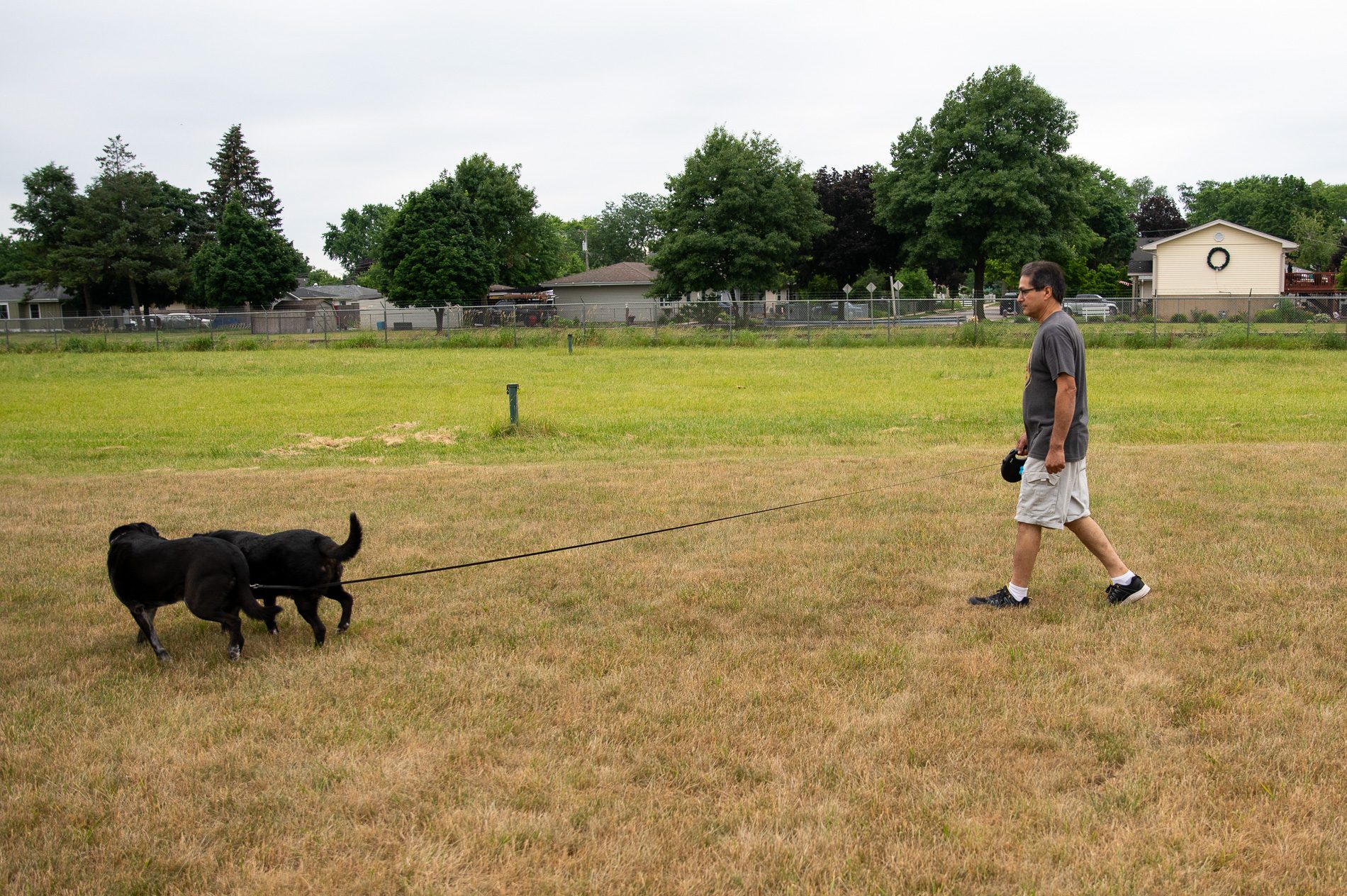
Se han presentado decenas de demandas contra la fábrica por daños a la salud y a la propiedad. Algunas... los que tienen influencia o conexiones políticasEn 1998, un juez de distrito condenó a Kerr-McGee a pagar $5 millones por "vigilancia médica". En 1998, cientos de familias obtuvieron una importante victoria legal cuando un juez de distrito ordenó a Kerr-McGee pagar $5 millones en concepto de "supervisión médica" para tener en cuenta los futuros efectos sobre la salud de los niños que vivían cerca de la fábrica.
La familia de Bartlett formó parte de la demanda. Ella y su hermana recibieron $4.000 cada una y a cambio acordaron no demandar a la empresa por futuros daños personales. "El abogado me dijo: 'Cógelo. Si te pones enferma no hay nada que puedas probar, tienen muy buenos abogados'", dijo Bartlett.
La leucemia de Bartlett reapareció en 2014. Tratamientos más nuevos y eficaces le han permitido vivir en remisión, pero la han dejado con niebla cerebral, problemas de visión y cognitivos.
El dinero del acuerdo "no llega muy lejos", dijo. "No sirve de nada cuando estás enfermo".
No es exactamente "historia pasada
En noviembre de 2015, el último vagón de ferrocarril con tierra contaminada con torio salió de West Chicago hacia un vertedero de residuos peligrosos en el desierto de Utah. El alcalde Pineda lo declaró un "momento decisivo." La limpieza se había estancado durante años después de que Tronox, la empresa derivada de Kerr-McGee, quebrara en 2009.
En la actualidad, la Instalación de Tierras Raras es propiedad de un fideicomiso gubernamental que canaliza fondos federales hacia la limpieza restante.
En opinión del alcalde, el desastre es ya "historia pasada". Está orgulloso de los activistas que consiguieron que la gente en el poder escuchara. La limpieza está casi terminada. Y ahora está listo para hablar de otras cosas.
"No quiero que esa palabra [torio] aparezca cada vez que se oiga 'West Chicago'", dijo Pineda.
Sin embargo, esa historia volverá a la vida este otoño, cuando la Agencia de Gestión de Emergencias de Illinois inicie la última fase de rehabilitación del emplazamiento de la fábrica.
La extensa contaminación de las aguas subterráneas bajo la fábrica está actualmente contenida por tablestacas que llegan a 70 pies bajo tierra, que se colocaron inicialmente para proteger a los trabajadores que excavaban suelo contaminado. Ahora atrapa los contaminantes residuales, impidiendo que las aguas subterráneas los diluyan de forma natural con el tiempo.
Más información
Una red de 122 pozos de control en el emplazamiento y sus alrededores muestra que varios contaminantes, sobre todo el uranio radiactivo, superan las normas estatales. Por ello, los residentes cercanos no pueden perforar nuevos pozos.
"Mientras los seres humanos no consuman las aguas subterráneas, no existe un peligro real para la salud", afirma Kelly Horn, Jefe de la Subdivisión de Servicios de Protección Radiológica del IEMA.
La agencia utilizará casi todos los $36 millones restantes de fondos federales para la operación, que durará entre tres y cinco años.
IEMA publicará un análisis medioambiental del proyecto de limpieza este verano, que Horn espera que no muestre ningún impacto negativo para los residentes.
"Dado que el suelo ha sido saneado y que el saneamiento de las aguas subterráneas producirá unos residuos mínimos, no existe riesgo alguno para la salud humana", afirma Horn.
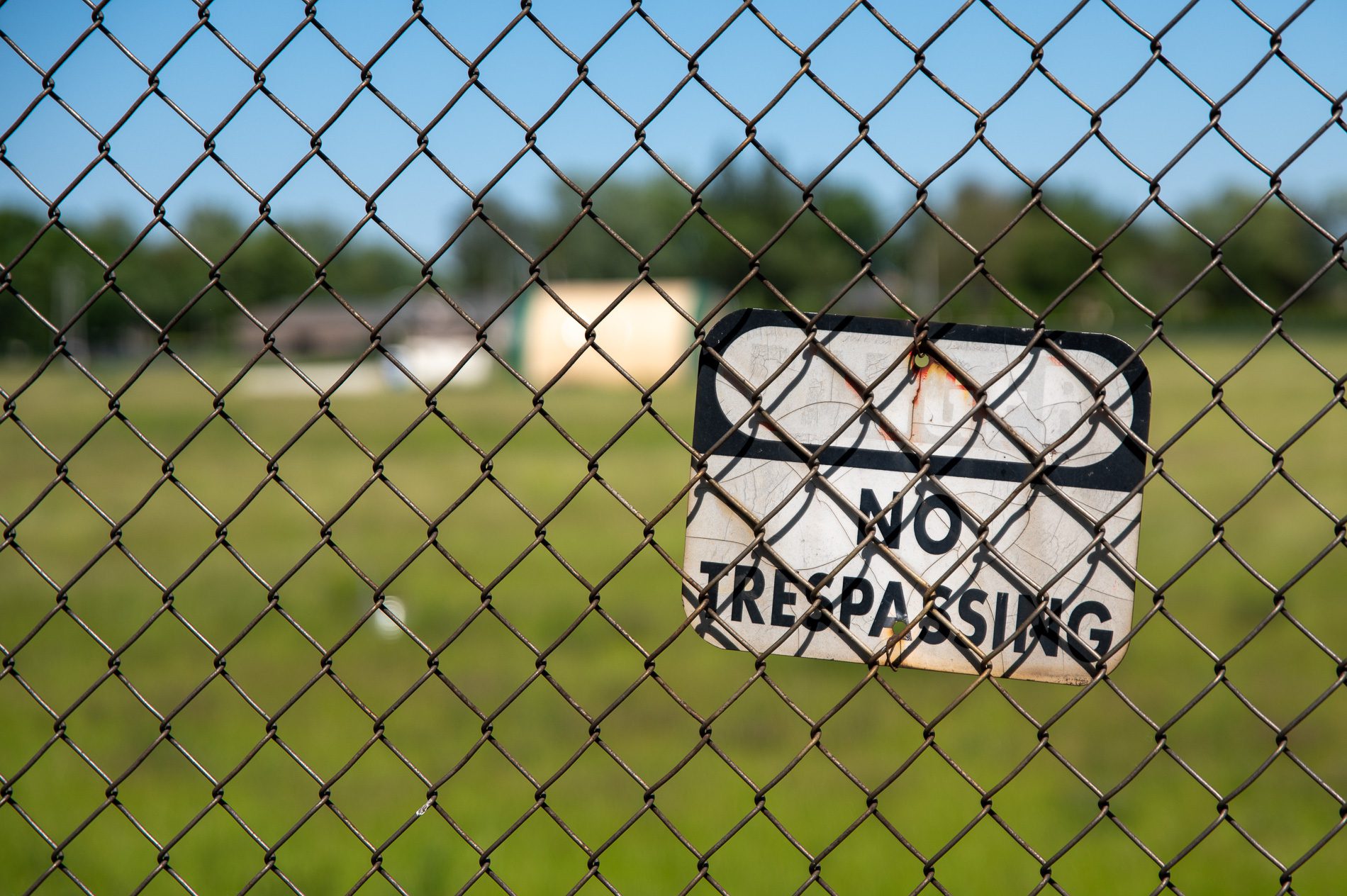
La ciudad de West Chicago planea construir un parque diseñado con las aportaciones de la comunidad en el emplazamiento de la antigua fábrica, una vez finalizada la rehabilitación. "Aunque la historia siempre estará ahí", dijo el administrador municipal Michael Guttman, "esperemos que en su lugar haya algo bastante estupendo".
Le pregunté a Guttman si la ciudad había pensado en colocar señales que recordaran la historia del lugar. Las víctimas de las bombas atómicas de Nagasaki e Hiroshima están conmemoradas en parques de la paz. Algunos vecinos quieren que se rinda homenaje a las personas afectadas por la planta de tierras raras, que suministró materiales para esas bombas.
"Aún no he pensado en ello", dijo Guttman.
"¿Quizá sea algo sobre lo que la comunidad pueda opinar?". pregunté.
Tras unos instantes de silencio al otro lado de la llamada, seguí adelante.
"Sigue ocurriendo"
Por un lado, la historia de West Chicago y el torio es triunfal: una pequeña ciudad supera las adversidades y consigue que una gran empresa limpie sus residuos radiactivos. Por otro lado, el torio sigue atormentando a algunos residentes, especialmente a los que viven con enfermedades o muertes en la familia que sospechan que están relacionadas.
Aunque la limpieza está casi terminada, Cavazos dijo que su comunidad quiere justicia reparadora. Quiere que se celebre un foro público en el que se reconozca el daño causado a la comunidad por Kerr-McGee, especialmente a las familias mexicanas que compraron propiedades contaminadas sin saberlo.
"Se ha perdido la narrativa del pasado. Desde los años 80 han intentado avanzar rápidamente", dijo Cavazos. "La gente de hoy sigue enferma por Kerr-McGee".
Kerr-McGee ya no existe. Muchos residentes no esperan ayuda para sus continuos problemas de salud. Y a falta de una respuesta oficial, algunos intentan mantener viva la historia por su cuenta.

Abraham Marshall, un antiguo residente cuya esposa sospecha que sus problemas autoinmunes están relacionados con la fábrica, publicó recientemente el primero de una serie de libros juveniles de ciencia ficción sobre la historia del torio en West Chicago para honrar a las víctimas. Bartlett y un estudiante de cine recopilaron las historias de sus vecinos en un documental de 2016, "A Lifetime Irradiated".
"Las empresas siguen lucrándose a costa de las personas vulnerables de la sociedad", afirmó Bartlett. "Lo ideal sería que suficientes personas fueran conscientes de este tipo de prácticas para que no siga ocurriendo".
Para Ester Escamilla Hughes, hablar del pasado de torio de West Chicago es encontrar apoyo para los continuos problemas de salud que le han surgido a ella y a otros residentes.
Las dos hermanas nunca sabrán a ciencia cierta si vivir cerca de la fábrica cuando eran niñas contribuyó a sus continuas enfermedades crónicas. Jacobo preguntó una vez a su endocrino sobre el tema y le cerró el pico. "Me hizo sentir como si hubiera hecho una pregunta tonta. Así que nunca seguí por ese camino", afirma. Entre los 125 miembros de la familia por parte de madre, ninguno tiene problemas de salud tan graves como ella y su hermana.
Otros médicos dijeron a Hughes que sus enfermedades podrían haberse desencadenado por trabajar en una cantera, donde estuvo expuesta al polvo de sílice. Se pregunta si haber crecido rodeada de residuos nucleares fue el problema subyacente que agravaron sus riesgos laborales.
Hablar con otros residentes ha reconfortado a Hughes, que sabe que no está sola.
"Cuando estás enfermo, piensas: 'Dios mío, ¿estoy loco? A veces los médicos te hacen sentir como si estuvieras loca", dice. Pero saber que otros residentes también comparten su historia ayuda. "Estamos sintiendo algo. Algo ocurrió. Y sigue ocurriendo".
Corrección 28/7/22: En una versión anterior de este artículo se afirmaba incorrectamente que la fábrica de Kerr-McGee está al norte de la casa de los Arzola.
Consulte nuestras FAQ para obtener respuestas a las preguntas más frecuentes sobre la contaminación radiactiva del oeste de Chicago.
¿Tienes alguna historia sobre West Chicago que quieras compartir? Envíenos un correo electrónico a [email protected].
Este artículo puede publicarse gratuitamente. Póngase en contacto con nosotros en [email protected] para obtener permiso y detalles sobre cómo puede utilizar nuestros informes.
Este informe ha contado con el apoyo del Fundación Internacional de Mujeres en los Medios Fondo Howard G. Buffett para Mujeres Periodistas y un premio del Instituto de Periodismo y Recursos Naturales.
Un agradecimiento especial a Erika Bartlett, que compartió documentos y fotos de sus años de investigación personal para esta historia.


